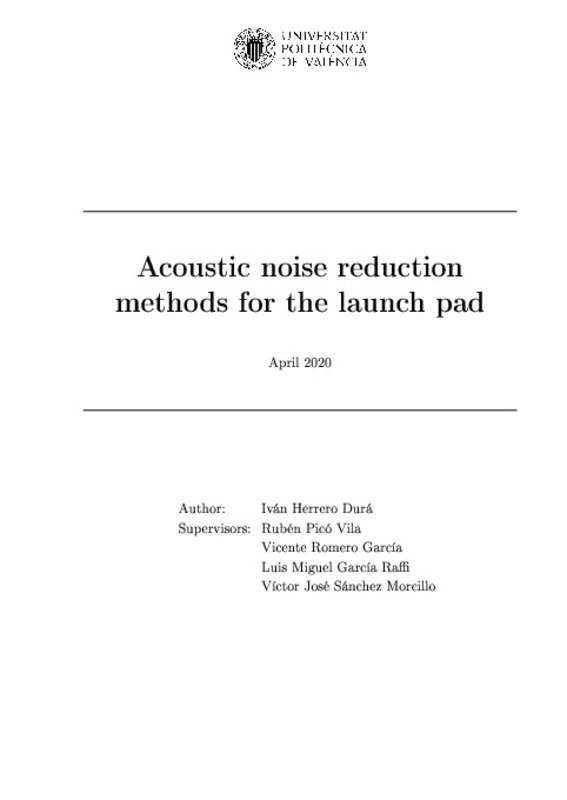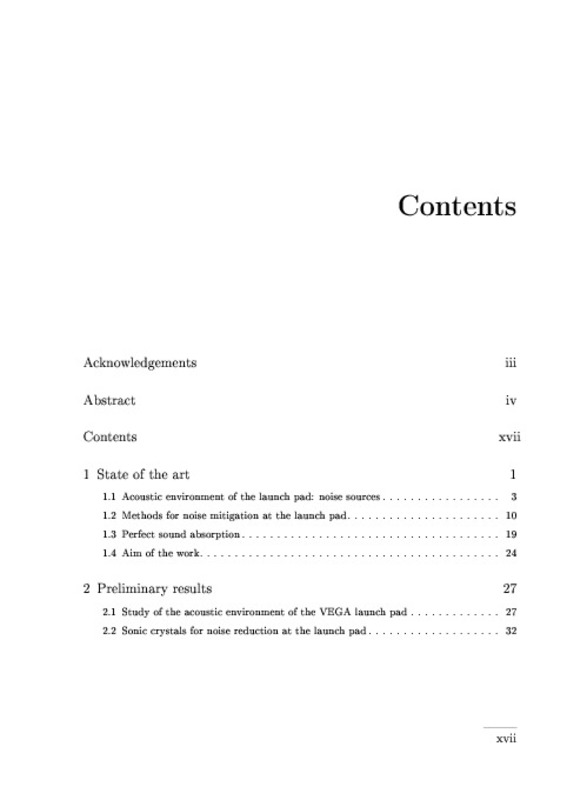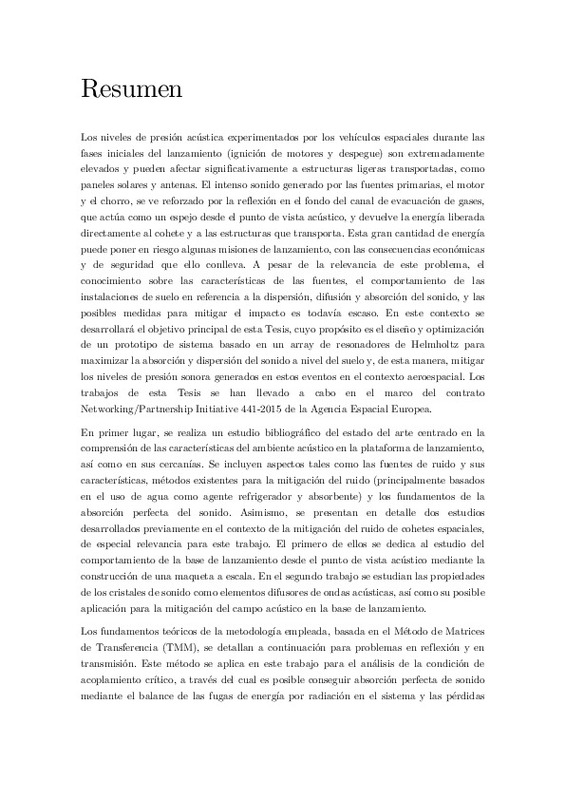- RiuNet repositorio UPV
- :
- Investigación
- :
- Tesis doctorales
- :
- Ver ítem
JavaScript is disabled for your browser. Some features of this site may not work without it.
Buscar en RiuNet
Listar
Mi cuenta
Estadísticas
Ayuda RiuNet
Admin. UPV
Acoustic noise reduction methods for the launch pad
Mostrar el registro sencillo del ítem
Ficheros en el ítem
| dc.contributor.advisor | García Raffi, Luis Miguel
|
es_ES |
| dc.contributor.advisor | Picó Vila, Rubén
|
es_ES |
| dc.contributor.advisor | Romero García, Vicente
|
es_ES |
| dc.contributor.advisor | Sánchez Morcillo, Víctor José
|
es_ES |
| dc.contributor.author | Herrero Durá, Iván
|
es_ES |
| dc.date.accessioned | 2020-06-19T08:16:54Z | |
| dc.date.available | 2020-06-19T08:16:54Z | |
| dc.date.created | 2020-05-18 | |
| dc.date.issued | 2020-06-19 | es_ES |
| dc.identifier.uri | http://hdl.handle.net/10251/146650 | |
| dc.description.abstract | [ES] Los niveles de presión acústica experimentados por las naves espaciales y las lanzaderas durante las fases iniciales del lanzamiento (ignición de motores y despegue) pueden ser muy significativos para estructuras ligeras y cargas externas y apéndices, como paneles solares y antenas. En este contexto, el fondo del canal de evacuación de gases actúa como un espejo desde el punto de vista acústico, y devuelve la energía liberada directamente al cohete y a las estructuras que transporta. Esta gran cantidad de energía puede poner en riesgo algunas misiones de lanzamiento, con las consecuencias económicas y de seguridad que ello conlleva. A pesar de esto, existe todavía poco conocimiento sobre las características de las fuentes y el comportamiento de las instalaciones de suelo en referencia a la dispersión, difusión y absorción del sonido. En este contexto se desarrollará el objetivo principal de esta Tesis, cuyo propósito es el diseño y optimización de un prototipo de sistema basado en un array de resonadores de Helmholtz para maximizar la absorción y dispersión del sonido y, por tanto, mitigar los niveles de presión sonora generados en estos eventos en el contexto aeroespacial. Los trabajos de esta Tesis se llevan a cabo en el marco del contrato Networking/Partnership Initiative de la Agencia Espacial Europea. | es_ES |
| dc.description.abstract | [CA] Els nivells de pressió acústica experimentats pels vehicles espacials durant les fases inicials del llançament (ignició de motors i enlairament) són extremadament elevats i poden afectar significativament a estructures lleugeres transportades, com panells solars i antenes. L'intens soroll generat per les fonts primàries, el motor i el raig, es veu reforçat per la reflexió en el fons del canal d'evacuació de gasos, que actua com un mirall des del punt de vista acústic, i retorna l'energia alliberada directament al coet i a les estructures que transporta. Aquesta gran quantitat d'energia pot posar en risc algunes missions de llançament, amb les conseqüències econòmiques i de seguretat que això comporta. Tot i la rellevància d'aquest problema, el coneixement sobre les característiques de les fonts, el comportament de les instal·lacions de sòl en referència a la dispersió, difusió i absorció del so, i les possibles mesures per mitigar l'impacte és encara escàs. En aquest context es desenvoluparà l'objectiu principal d'aquesta Tesi, el propòsit de la qual és el disseny i optimització d'un prototip de sistema basat en una matriu de ressonadors de Helmholtz per maximitzar l'absorció i dispersió del so a nivell de terra i, d'aquesta manera, mitigar els nivells de pressió sonora generats en aquests esdeveniments en el context aeroespacial. Els treballs d'aquesta Tesi s'han dut a terme en el marc del contracte Networking/Partnership Initiative 441-2015 de l'Agència Espacial Europea. | es_ES |
| dc.description.abstract | [EN] The sound pressure levels experienced by space vehicles during the initial stages of launch (engine ignition and lift-off) are extremely high and can significantly affect light transported structures, such as solar panels and antennas. The intense sound generated by the primary sources, the engine and the jet, is reinforced by the reflection at the bottom of the gas evacuation channel, which acts as a mirror from the acoustic point of view, and returns the energy released directly to the rocket and the structures it carries. This large amount of energy can put some launch missions at risk, with the economic and security consequences that this entails. Despite the relevance of this problem, knowledge about the characteristics of the sources, the behavior of ground facilities in reference to the dispersion, diffusion and absorption of sound, and the possible measures to mitigate the impact is still scarce. In this context, the main objective of this thesis will be developed. The purpose of this work is the design and optimization of a prototype system based on an array of Helmholtz resonators to maximize the absorption and dispersion of sound at ground level and, in this way, mitigate the sound pressure levels generated in these events in the aerospace context. The work of this thesis has been carried out within the framework of the Networking/Partnership Initiative contract 441-2015 of the European Space Agency. | es_ES |
| dc.description.sponsorship | None of the work presented here could have been possible without the funding provided by the European Space Agency. In this institution, I want to specially thank Julián Santiago (who sadly passed away in December 2018) and Ivan Ngan, both from the Structures, Mechanisms and Materials Division, for their help to make this project possible. | es_ES |
| dc.language | Inglés | es_ES |
| dc.publisher | Universitat Politècnica de València | es_ES |
| dc.rights | Reserva de todos los derechos | es_ES |
| dc.subject | Acoustics | es_ES |
| dc.subject | Noise reduction | es_ES |
| dc.subject | Sound absorption | es_ES |
| dc.subject | Sound diffusion | es_ES |
| dc.subject | Absorption coefficient | es_ES |
| dc.subject | Diffusion coefficient | es_ES |
| dc.subject | Helmholtz resonators | es_ES |
| dc.subject | Rocket lift-off | es_ES |
| dc.subject | Launch pad | es_ES |
| dc.subject.classification | FISICA APLICADA | es_ES |
| dc.subject.classification | MATEMATICA APLICADA | es_ES |
| dc.title | Acoustic noise reduction methods for the launch pad | es_ES |
| dc.type | Tesis doctoral | es_ES |
| dc.identifier.doi | 10.4995/Thesis/10251/146650 | es_ES |
| dc.relation.projectID | info:eu-repo/grantAgreement/ESA//2441-2015/ | es_ES |
| dc.rights.accessRights | Abierto | es_ES |
| dc.contributor.affiliation | Universitat Politècnica de València. Departamento de Matemática Aplicada - Departament de Matemàtica Aplicada | es_ES |
| dc.description.bibliographicCitation | Herrero Durá, I. (2020). Acoustic noise reduction methods for the launch pad [Tesis doctoral]. Universitat Politècnica de València. https://doi.org/10.4995/Thesis/10251/146650 | es_ES |
| dc.description.accrualMethod | TESIS | es_ES |
| dc.type.version | info:eu-repo/semantics/acceptedVersion | es_ES |
| dc.relation.pasarela | TESIS\11444 | es_ES |
| dc.contributor.funder | European Space Agency | es_ES |
Este ítem aparece en la(s) siguiente(s) colección(ones)
-
Tesis doctorales [5389]










